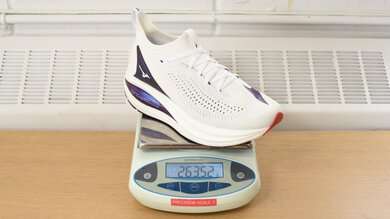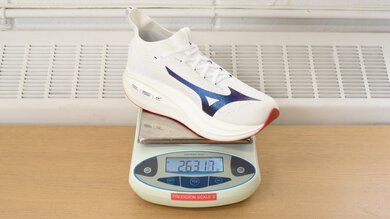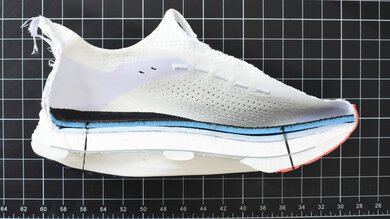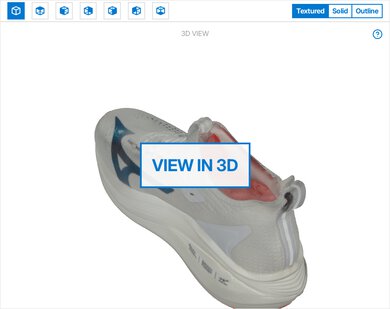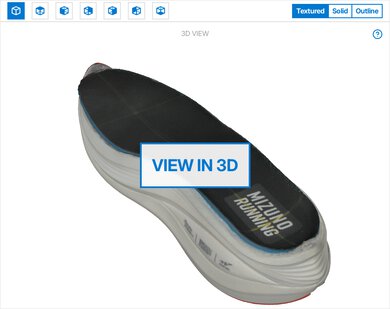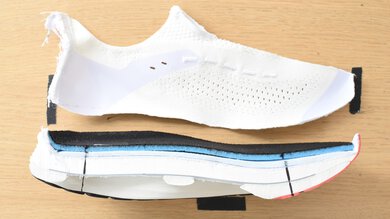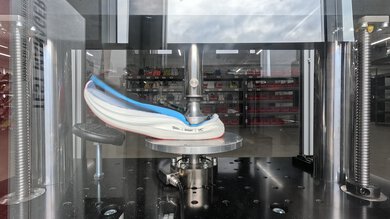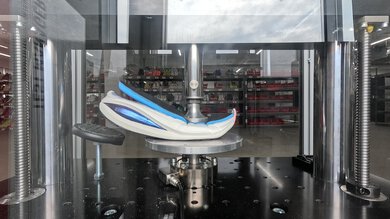The Mizuno Neo Vista 2 is a bold, high-stack evolution of Mizuno's max-cushioned trainer, taking everything from the original and pushing it to the extreme. With a towering heel stack of 50mm, a softer top layer of Enerzy Next foam, and a redesigned outsole for more complete ground coverage, the ride now feels smoother and plusher, especially over long distances. However, while the updated midsole delivers a more protective and refined experience, the upper fit can be problematic. It's really loose and oversized, leading to a sloppy feel on foot that compromises lockdown unless you adjust the sizing. With this more exaggerated design, the Neo Vista 2 positions itself further as an ultra-cushioned option for easy runs of various distances, but in practice, this also limits its appeal beyond that niche.
Our Verdict
The Mizuno Neo Vista 2 performs decently for marathon efforts, offering an extremely cushioned, forgiving ride that excels during long, steady sessions. The super high stack effectively softens ground impact. However, its below-average energy return and heavier build make it feel sluggish when trying to pick up the pace. Combined with a loose upper and not the most stable platform, this is best suited for slower runners looking for comfort and protection rather than elite-level marathon performance.
Fantastic cushioning.
Plastic plate adds some rigidity and control.
Quite heavy.
The forefoot doesn't provide much propulsion.
The Mizuno Neo Vista 2 is an okay option for shorter race efforts. Its sluggish geometry and the mushy midsole make it hard to generate the fast turnover required for 5K and 10K paces. The soft forefoot contributes to a mushy feel that lacks snapiness, and the shoe's weight drags it further away from true racing territory. While the plate adds some stability, it doesn't entirely offset the softness and bulk. This is not an optimal choice for faster efforts.
Plastic plate adds some rigidity and control.
Quite heavy.
The forefoot doesn't provide much propulsion.
The Mizuno Neo Vista 2 offers only middling energy return, despite using Mizuno's Enerzy Next foam on the top layer. Forefoot bounce is especially middling, which contributes to a dampened sensation at toe-off. This is noticeable at faster paces, where the shoe feels more like it absorbs momentum than propels you forward. The smooth rolling sensation is fun for runners sticking to slow to moderate paces, but those seeking a shoe to pick up the pace in will be left wanting.
The heel is somewhat bouncy.
The forefoot doesn't provide much propulsion.
Cushioning is where the Mizuno Neo Vista 2 shines. The shoe delivers outstanding underfoot protection, with a very plush heel and forefoot that is super well-cushioned. The dual-layer midsole offers gentle landings for short recovery miles and longer runs. Regardless of your strike pattern, it's a max-cushion experience through and through, which is perfect for soaking up pounding during high mileage days. Runners looking for softness above all else will appreciate this.
Fantastic cushioning.
Super high stack makes for super protective ride.
The Mizuno Neo Vista 2 feels slightly unstable laterally due to its ultra-tall stack and soft midsole. While the shoe's base is wide, and the plate adds some stiffness, the extremely soft heel makes it feel wobbly. The upper is also both accommodating and supportive, provided you manage to nail the sizing. Overall, stability is adequate for straightforward relaxed runs, but runners needing more lateral stability may struggle with overall control.
Plastic plate adds some rigidity and control.
Wide platform.
Soft foam all around.
High stack means you're far from the ground.
Performance Usages
Changelog
- Updated Oct 28, 2025: We've converted this review to Test Bench 0.9, which adds a Forefoot Long Run Cushioning test to our performance section. Read more in our changelog.
-
Updated Oct 20, 2025:
We've adjusted this review's writing to align with the new test bench, including updates to all usage scores, and test boxes for Cushioning, Firmness, and Energy Return. We've updated the side-by-side comparisons with other shoes accordingly.
- Updated Oct 20, 2025: We've converted this review to Test Bench 0.8.2, which updates our methodology for the impact force range used in our compression tests to improve their accuracy. This also affects all usage and performance usage boxes using those compression tests as score components.
-
Updated Jul 30, 2025:
We updated the Marathon Racing box and the Forefoot Cushioning box to align with the latest test bench scores.
Check Price
Differences Between Sizes And Variants
We tested the Mizuno Neo Vista 2 in men's US size 9, as indicated on the label of our pair. The color shown here is White. This model is also available in another colorway, Baritone Blue/Frozen Emerald. Wide versions are not available. The design section applies only to the exact model we tested, but we expect other size and gender variants to perform similarly.
Popular Running Shoe Comparisons
Compared to other max-cushion trainers on the market, the Mizuno Neo Vista 2 pushes the envelope even further in terms of stack height and underfoot softness. While models like the HOKA Skyward X, Brooks Glycerin Max, or ASICS NOVABLAST 5 are all well-cushioned in their own right, the Neo Vista 2 simply delivers more foam underfoot—especially in the heel—resulting in an ultra-soft, muted ground feel that few shoes can match. What sets it apart even more is the inclusion of a plastic plate, not for propulsion, but to help stabilize and hold the exceptionally soft dual-foam setup together. Despite all this cushioning, it remains quite lightweight for the category, but the upper is quite loose, and the shoe runs long, which can impact lockdown negatively unless you size down. Overall, you're best off using it for easy runs and recovery runs where you just have to get through the session, and protection is paramount.
Within Mizuno's lineup, this shoe is the dedicated max-cushion cruiser, ideal for long-distance comfort and garbage miles. There's also Mizuno Neo Zen, which offers a more bouncy, fun daily trainer experience at a lower stack and weight. Meanwhile, the Mizuno Wave Rider 29 serves as the brand's traditional daily trainer—firmer, lower to the ground, and more structured.
For more options, check out our recommendations for the best running shoes, as well as the best running shoes for men and the best running shoes for women.
The Mizuno Neo Zen and Mizuno Neo Vista 2 are both high-stack daily trainers from the Osaka-based company, but are tailored to very different needs. The Neo Zen is lighter, simpler, and more playful—built around a single layer of foam with no plate, giving it a soft, bouncy ride that's ideal for everyday miles. The Neo Vista 2, on the other hand, is a much more protective and max-cushioned option. It has a much higher stack height and a plastic plate to stabilize the large midsole. The result is a more absorbing ride, especially during long runs and back-to-back mileage days, but it feels heavier and less energetic than the Neo Zen. However, the high-volume upper runs long and introduces lockdown issues that aren't present in the Zen.
The Mizuno Neo Vista 2 is the sequel to the original Mizuno Neo Vista, but the second iteration brings a different take to the table. The original Neo Vista pitches itself as a plated super trainer, but it struggled to deliver the necessary pop and snappiness to justify that positioning. The ride feels more adapted to recovery runs than anything. The Neo Vista 2 embraces what the first version hinted at but didn't fully commit to. It increases stack height noticeably and updates the midsole foam, which shifts the experience toward max-cushion recovery territory. The ride is more cohesive, and the Neo Vista 2 feels more cushioned and better defined in purpose. However, it introduces fit issues that weren't present in the first version—running longer and feeling sloppier around the heel due to a more high-volume upper and longer base.
The Mizuno Neo Vista 2 and HOKA Skyward X both occupy the niche of ultra-cushioned, plated trainers designed for long miles and recovery runs, but they take very different approaches. The Mizuno uses a towering stack of foam paired with a plastic plate, delivering a deeply cushioned experience (especially in the heel) that's almost as plush as the HOKA. Despite all that foam, it still comes in lighter, making it easier to turn over during long efforts. The HOKA, on the other hand, leans on a more structured, H-shaped carbon plate embedded in the soft and responsive midsole. It delivers a slightly softer feel overall, and its upper is more traditional, offering a more standard fit compared to the Mizuno shoe's high-volume, roomy construction.
The Mizuno Neo Vista 2 and Brooks Glycerin Max both target the max-cushioned daily trainer category, offering plush rides suited for easy running. That said, they approach the task quite differently. The Mizuno is the most cushioned option underfoot, featuring a massive stack of foam combined with a plastic plate to help stabilize the soft platform. Its ride is more protective, though it leans toward a more recovery-oriented feel and can feel a bit unstable due to the ultra-soft midsole and loose upper. The Brooks, by contrast, delivers a slightly firmer, more traditional take on max cushioning. It has a wide platform, smooth rocker, and no plate, which gives it a more natural ride. While not as soft or deeply cushioned as the Mizuno, the Brooks offers a more predictable feel, with an upper that's more secure and familiar in fit.

We've recently started buying and testing running shoes with a very data-oriented approach. While we're just getting started, our methodology already has dozens of tests to help you make the right purchasing decision for your needs. Not only do we use high-end equipment to gather objective data, but we also order multiple sizes of the same shoes for team members to be able to log in miles. This real-world testing is done at various paces and conditions, and with different types of workouts, to cover all the bases. This allows us to verify our results and ensure they align with what you might feel with a specific pair.
Test Results

With a super high stack height, the Mizuno Neo Vista 2 fully embraces the maximalist trend, packing a lot more foam underfoot than the previous Mizuno Neo Vista for increased protection.
This shoe is simply too long to call true to size, especially at larger sizes where the length discrepancy becomes more exaggerated. The toe box is wide, and the upper is quite loose, which is appreciated for higher-volume feet but can be problematic for runners with narrow feet. This results in bad lockdown and some lateral movement, making the ride feel inefficient. However, everything comes together nicely when sizing down, and the ride becomes much more enjoyable. Obviously, that makes it a good option for folks with wide feet.
The heel energy return is unremarkable. While there's enough rebound to add a bit of spice to your runs, it doesn't feel especially propulsive. The geometry helps you roll forward as the foam decompresses, but it's not as bouncy and fun as alternatives like the Mizuno Neo Zen.
The forefoot energy return is quite low, as the shoe feels noticeably unresponsive in this area. This setup works fine for easy miles, but the foam lacks the liveliness needed to pick up the pace with ease.
Heel cushioning is outstanding on this shoe. The taller platform means there's more foam available to absorb impacts, and it holds up even over longer efforts. This level of protection makes it ideal for recovery runs and heavy mileage.
The forefoot is remarkably cushioned. While not as deep as the heel, there's still ample foam underfoot, resulting in a forgiving ride even for forefoot strikers. The added foam from the updated midsole plays a key role in effectively absorbing impacts.
The heel is super soft and even softer than the previous iteration. It offers a very plush, forgiving ride, but the downside is reduced stability, which can be important for runners requiring more help to keep their balance.
The forefoot is on the soft side. It contributes to the shoe's overall comfort, but makes the platform feel less structured underfoot, especially compared to other trainers like the Nike Vomero 18. It's great if you like that plush feeling, but not ideal if you want a stable, snappy toe-off.

